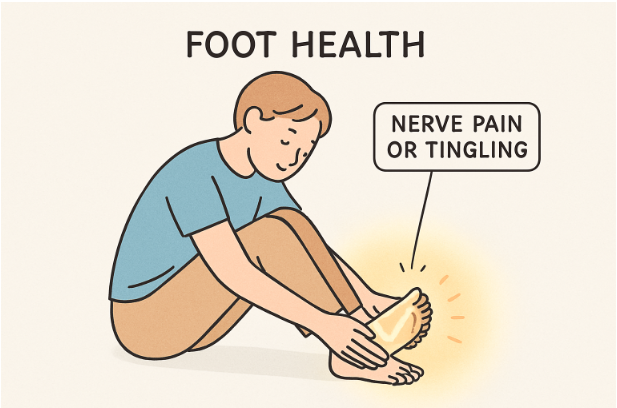Key Takeaways
- Diabetic Peripheral Neuropathic Pain (DPNP) significantly affects quality of life and mental health.
- Effective management includes a combination of pharmacological treatments, lifestyle modifications, and alternative therapies.
- Emerging treatments like spinal cord stimulation and new medications show promise in alleviating DPNP symptoms.
Contents
Understanding Diabetic Peripheral Neuropathic Pain
Diabetic Peripheral Neuropathic Pain (DPNP) is a common and challenging complication for many people living with diabetes. This condition stems from progressive nerve damage caused by persistent high blood sugar levels, leading to symptoms that range from subtle tingling and numbness to severe burning and shooting pain, particularly in the feet and legs. Not only are the physical symptoms distressing, but DPNP can take a considerable toll on emotional well-being.
Managing DPNP calls requires a proactive and multifaceted approach. Newly diagnosed patients, as well as those struggling to find adequate pain relief, may benefit from exploring participation in an open clinical trial for chronic pain. This trial provides access to innovative therapies under development and helps advance research in this field. Current research sheds light on the many factors influencing DPNP, making education and involvement crucial for those impacted by this condition.
The burden of living with DPNP extends far beyond physical symptoms. Many experience sleep disturbances, increased anxiety, and even depression as they cope with persistent pain and reduced mobility. As DPNP can often result in limitations in daily activities and social interactions, its impact on quality of life should not be underestimated. According to the American Diabetes Association, addressing physical and psychological effects is essential for successful management and improved outcomes. Effective DPNP management aims to maintain optimal blood sugar control to slow the progression of nerve damage in addition to pain relief. Often, a holistic plan involving medical therapy, lifestyle changes, and supportive care offers the best results. Staying up to date with new developments and engaging in research-based opportunities are critical steps for patients and their healthcare teams.
Pharmacological Treatments
Pharmacological interventions remain the backbone of DPNP management. Physicians typically start with medication regimens known for effectiveness in neuropathic pain relief. Among the most frequently prescribed are:
- Anticonvulsants: Drugs such as pregabalin and gabapentin, developed to treat seizures, are often repurposed to calm overactive nerve signals in DPNP, providing substantial symptom relief for many patients.
- Antidepressants: Medications like duloxetine, a serotonin-norepinephrine reuptake inhibitor, and tricyclics such as amitriptyline help manage both pain and the comorbid depression that can develop in chronic conditions. Duloxetine, in particular, has been approved by the FDA for DPNP treatment.
While these medications offer benefits, they may also be accompanied by side effects, including dizziness, fatigue, dry mouth, and weight changes. Patients must work closely with their healthcare providers to customize medication choices and minimize side effects.
Lifestyle Modifications
Beyond medications, lifestyle choices can play a transformative role in symptom management and long-term health. Consistent, moderate exercise promotes improved circulation, easing nerve pain and enhancing mobility. Activities like swimming, walking, or gentle yoga are often recommended for their ability to bolster both physical and mental health.
Dietary adjustments also contribute meaningfully. An anti-inflammatory diet emphasizing fruits, vegetables, whole grains, lean proteins, and healthy fats may help manage pain and reduce complications. These nutritional steps are also fundamental in supporting long-term diabetes management.
Alternative Therapies
An increasing number of individuals are turning to alternative therapies to augment conventional treatments for DPNP. Acupuncture has demonstrated pain-relieving effects by stimulating the release of endogenous painkillers, offering a non-pharmacological avenue for those looking to minimize medication usage. Similarly, regular massage therapy helps to improve circulation, ease tension, and enhance comfort for those suffering from chronic nerve pain. Before beginning any alternative or complementary therapy, discussing options with a healthcare provider is important to prevent potential interactions or complications with existing treatments.
Emerging Treatments
Recent advances in DPNP management have introduced novel therapies that promise better results for those with treatment-resistant pain. Spinal cord stimulation (SCS) is one such approach. A minimally invasive device delivers low-level electrical impulses to the spinal cord, disrupting pain signals before they reach the brain. Clinical studies have shown that SCS can deliver consistent pain reduction and improve quality of life for selected patients. In addition to device-based treatments, pharmaceutical research is rapidly evolving. New medications targeting specific nerve pain pathways, such as LX9211, are in various stages of clinical trials, raising hope for options that are both effective and have fewer side effects. Engaging in an open clinical trial for chronic pain can offer patients access to these futuristic therapies while helping expand the knowledge base for DPNP care.
Psychological Support
A comprehensive approach to DPNP must acknowledge the psychological and social challenges that accompany chronic pain. Persistent discomfort often leads to anxiety, depression, and a sense of isolation. Integrating mental health support – including cognitive-behavioral therapy (CBT), individual counseling, or participation in support groups – provides coping strategies, emotional relief, and fosters resilience. These steps are essential in restoring hope and improving day-to-day functioning for those affected.
Conclusion
Diabetic Peripheral Neuropathic Pain is a complex, multifactorial condition that requires an individualized, multidisciplinary approach for optimal management. Combining medications, healthy lifestyle practices, complementary therapies, and a solid support network addresses the condition’s physical and psychological facets. Staying updated on new and emerging treatments, such as those available in open clinical trials for chronic pain opportunities, empowers patients to participate actively in their care and pursue a better quality of life.




